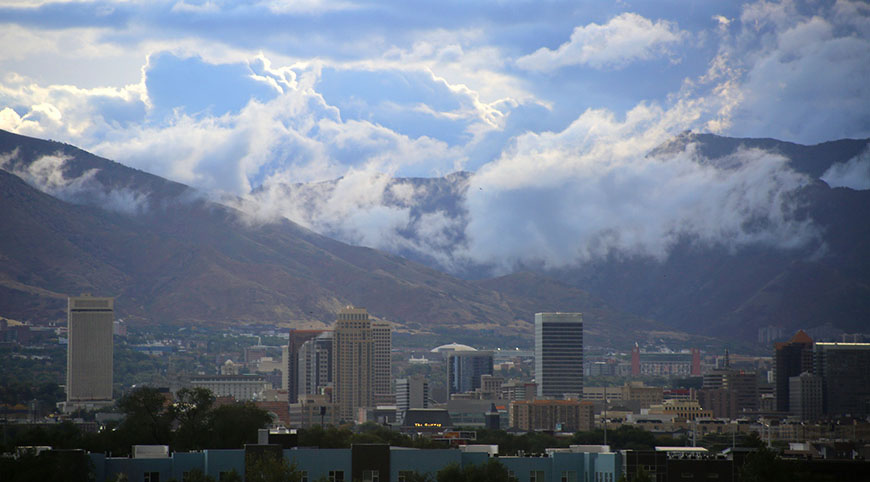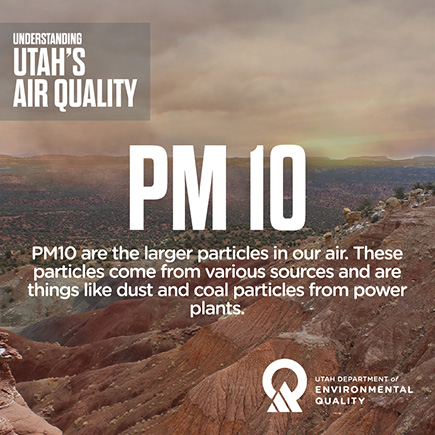
Compliance Program Protects Air Quality
Did you know that there are over 1,500 stationary emission sources in Utah, along with several hundred federal and state air quality rules and regulations that cover these sources? Our program, which includes inspections, compliance assistance, and enforcement, protects the public and the environment from air pollution and assists businesses in meeting the terms of their permit. It’s a win-win proposition that reduces emissions and saves facilities time and money over the long run.
So what’s a stationary source, exactly? Well, it’s pretty much what you would think — an emission source that is sited at a specific location. There are two types of stationary sources: major and minor. A major source has the potential to emit at least 100 tons per year of any criteria pollutant, and a minor source has the potential to emit more than 5 tons but less than 100 tons per year. The following compliance activities help major and minor sources meet the emission limits established in their permits:
- Monitoring
- Testing
- Sampling
- Record-keeping
- Reporting
These requirements ensure that facilities test their equipment, monitor emissions, and submit regularly scheduled reports to the Division of Air Quality (DAQ) to demonstrate compliance with their permits. You might be surprised by the different kinds of operations that qualify as minor sources: gravel pits, oil and gas facilities, chemical manufacturers, coal mines, and food processing operations. We even conduct inspections at manufacturing plants for diapers, airbags, and bowling balls!
We typically conduct an inspection of a minor stationary source once every three years. Our staff prepares for an inspection by reviewing all applicable rules, emission tests, compliance reports, and approval orders. Our inspections are unannounced, so naturally, it seems like an inspector always shows up at the most inconvenient time! Once on site, we review all of the rules that apply to the source, review and record the operating parameters, look over the equipment, and request records.
After the source provides the requested information, we write up an inspection memo. For the most part, the companies regulated by DAQ operate in compliance with the rules and regulations that apply to them. For those that are not in compliance, we initiate an enforcement action. This may involve the payment of a penalty, and companies are required to get back into compliance in a timely manner.
Area Source Rules
Over the past few years, DAQ has implemented over 30 new state rules to reduce emissions from area sources to meet the National Ambient Air Quality Standards (NAAQS) for PM2.5. These rules apply to thousands of area sources. Area sources cover a wide range of small businesses and households. The new rules limit volatile organic compound (VOC) emissions in everything from:
- consumer products
- adhesives and sealants
- surface coatings
- degreasing
- solvent cleaning operations
- graphic arts operations
Because the businesses that use these VOC-emitting products are scattered over a wide area and aren’t always subject to a minor source permit, we have been actively engaging in education and outreach to ensure that these businesses know about the air quality requirements and understand the measures they can take to comply with the rules. See a list of the area source rules …
Oil and Gas ULend Program for IR Camera
The ULend program is a collaborative approach for fixing compliance issues before they become a regulatory problem. The program focuses on small oil and gas producers who might not be able to afford the kind of expensive equipment that could help them identify and repair leaks early.
Volatile organic compounds (VOCs) are a major contributor to elevated ozone levels in the Uinta Basin. The ULend program will help operators identify and repair VOC leaks at oil and gas sources. Benefits include:
- Recovery of marketable product that would otherwise be lost
- Decrease in VOC emissions
- Lower ozone values in the Basin
- Collaborative approach between the Division of Air Quality (DAQ) and industry
- Loan program for state of the art infrared (IR) camera for leak detection
- Training and certification in camera use provided by the ULend program
Program Features
The ULend program alleviates much of the cost burden associated with leak-detection programs. Companies can forego the purchase of a $100,000 IR camera as well as the added cost of hiring a camera contractor (about $7,000/week) since ULend will provide training in the camera’s use to program participants.

Fugitive Dust Control Requirements
Fugitive dust is particles of soil, ash, coal, minerals, etc., which becomes airborne because of wind or mechanical disturbance. Fugitive dust can be generated from natural causes such as wind or from manmade causes such as unpaved haul roads and operational areas, storage, hauling and handling of aggregate materials, construction activities and demolition activities. Fugitive dust contributes particulate matter (PM) emissions to the atmosphere. PM emissions must be minimized in order to meet National Ambient Air Quality Standards (NAAQS). The regulations described herein are for the following areas of the state:
- all regions of Salt Lake and Davis counties
- all portions of the Cache Valley
- all regions in Weber and Utah counties west of the Wasatch mountain range
- in Box Elder County, from the Wasatch mountain range west to the Promontory mountain range and south of Portage
- in Tooele County, from the northernmost part of the Oquirrh mountain range to the northern most part of the Stansbury mountain range and north of Route 199.
Visible Emissions
Fugitive dust is limited to an opacity of 20% or less on-site, and 10% or less at the property boundary. Opacity is a measurement of how much visibility is obscured by a plume of dust. For example, if a plume of dust obscures 20% of the view in the background, the visible emissions from the dust plume is 20% opacity.
Fugitive Dust Control Plans
In addition to opacity limits, any source ¼ acre or greater in size is required to submit a Fugitive Dust Control Plan (FDCP) to the Utah DAQ. The FDCP is required to help sources minimize the amount of fugitive dust generated on-site. A source is required to submit a FDCP prior to initial construction or operation and prior to any modifications made on-site that effect fugitive dust emissions.
Roadways
Any person whose activities result in fugitive dust from a road shall minimize fugitive dust to the maximum extent possible. Any person who deposits materials that may create fugitive dust on a public or private paved road shall clean the road promptly. Any person responsible for construction or maintenance of any existing or new road or having right-of- way easement or possessing the right to use a road shall minimize fugitive dust to the maximum extent possible. This includes site entrances and exits for vehicles.
All areas in the state not listed above are regulated by the statewide fugitive dust rules.
DAQ Incentive Program
The Utah Division of Air Quality administers several incentive programs created to encourage individuals and businesses to reduce emissions. These programs include Alternative Fuel , Clean Air Retrofit Replacement and Off-Road Technology (CARROT) Program , Clean Diesel , Natural Gas , Vehicle Tax Credit , Volkswagen , VRRAP and the Wood Stove Conversion Assistance Program
Find more details regarding qualifications and how to apply for the programs …

